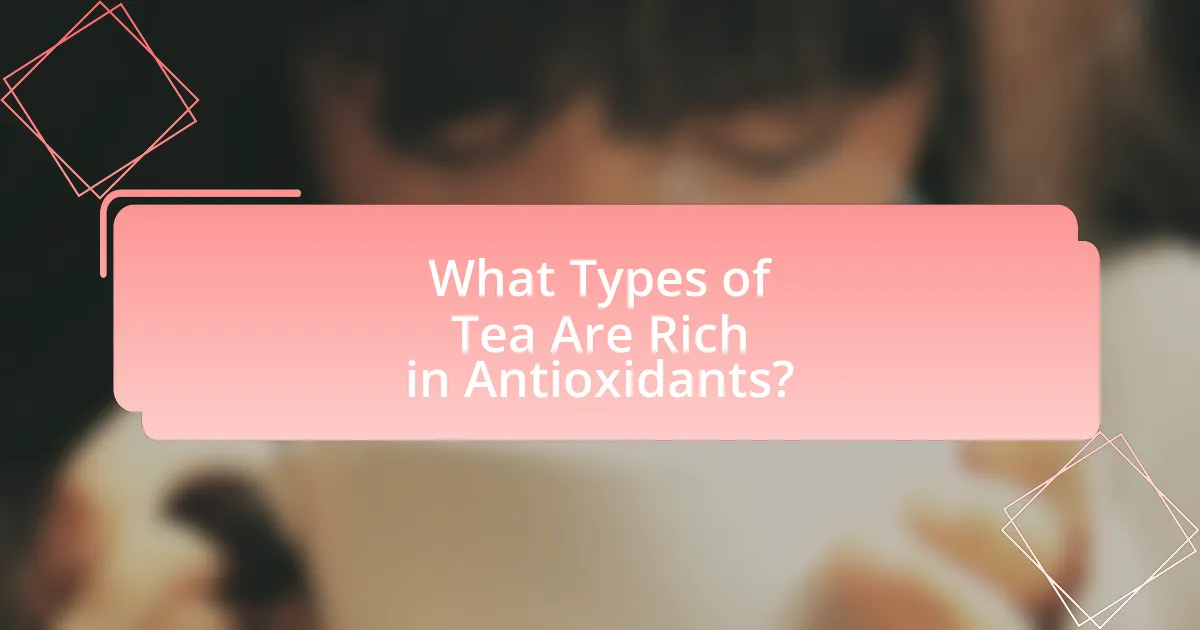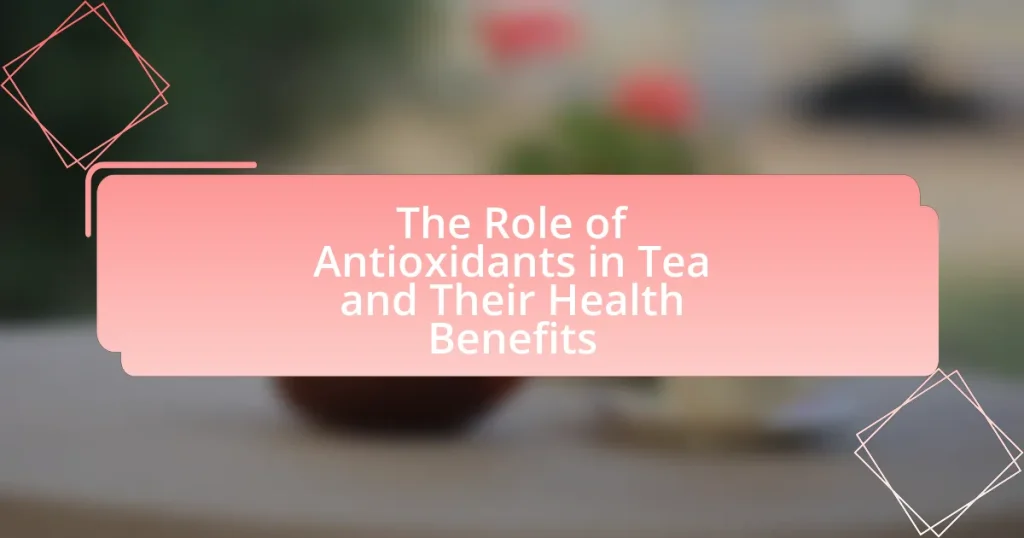Antioxidants are vital compounds that inhibit oxidation and neutralize free radicals, playing a crucial role in protecting cellular health. This article explores the types of antioxidants found in tea, particularly catechins and flavonoids, and their significant health benefits, including reducing the risk of chronic diseases such as cardiovascular issues and certain cancers. It discusses how antioxidants function in the body, the impact of different tea varieties on antioxidant levels, and practical tips for maximizing antioxidant intake through proper brewing methods. Additionally, the article highlights the relationship between tea consumption, mental health, and weight management, emphasizing the importance of antioxidants in promoting overall well-being.

What are Antioxidants and Their Role in Tea?
Antioxidants are compounds that inhibit oxidation and neutralize free radicals in the body, thereby protecting cells from damage. In tea, particularly green and black varieties, antioxidants such as catechins and flavonoids play a significant role in promoting health by reducing oxidative stress, which is linked to chronic diseases. Research indicates that the high concentration of these antioxidants in tea can contribute to cardiovascular health, improve brain function, and lower the risk of certain cancers, as evidenced by studies published in journals like the Journal of Nutritional Biochemistry, which highlight the protective effects of tea-derived antioxidants on cellular health.
How do antioxidants function in the body?
Antioxidants function in the body by neutralizing free radicals, which are unstable molecules that can cause oxidative stress and damage cells. This neutralization occurs through various mechanisms, including donating electrons to free radicals, thereby stabilizing them and preventing cellular damage. Research indicates that antioxidants, such as vitamins C and E, as well as polyphenols found in tea, play a crucial role in reducing the risk of chronic diseases by mitigating oxidative stress and inflammation. For instance, a study published in the Journal of Nutritional Biochemistry demonstrated that the polyphenols in green tea significantly reduce oxidative stress markers in the body, highlighting their protective effects.
What types of antioxidants are found in tea?
Tea contains several types of antioxidants, primarily catechins, flavonoids, and polyphenols. Catechins, such as epicatechin gallate (EGCG), are the most abundant and are known for their strong antioxidant properties. Flavonoids, which include quercetin and kaempferol, contribute to the overall antioxidant capacity of tea. Polyphenols, a broader category that encompasses catechins and flavonoids, are also significant in combating oxidative stress. Research indicates that these antioxidants can help reduce the risk of chronic diseases by neutralizing free radicals in the body.
How do these antioxidants interact with free radicals?
Antioxidants interact with free radicals by donating electrons, which neutralizes the free radicals and prevents them from causing cellular damage. This electron donation stabilizes the free radicals, effectively reducing their reactivity and potential harm to biological molecules such as DNA, proteins, and lipids. Research has shown that compounds like catechins found in tea exhibit strong antioxidant properties, significantly reducing oxidative stress in cells, which is linked to various chronic diseases.
Why are antioxidants important for health?
Antioxidants are important for health because they protect the body from oxidative stress caused by free radicals. Free radicals are unstable molecules that can damage cells, leading to chronic diseases such as cancer, heart disease, and neurodegenerative disorders. Research indicates that antioxidants, such as those found in tea, can neutralize these free radicals, thereby reducing the risk of these diseases. For example, studies have shown that polyphenols in green tea can lower the risk of cardiovascular diseases by improving endothelial function and reducing inflammation.
What health issues are linked to oxidative stress?
Oxidative stress is linked to several health issues, including cardiovascular diseases, neurodegenerative disorders, diabetes, and cancer. Research indicates that oxidative stress results from an imbalance between free radicals and antioxidants in the body, leading to cellular damage. For instance, studies have shown that oxidative stress contributes to the pathogenesis of atherosclerosis, Alzheimer’s disease, and type 2 diabetes by promoting inflammation and damaging cellular components. The World Health Organization has recognized the role of oxidative stress in these conditions, emphasizing the importance of antioxidants in mitigating these health risks.
How do antioxidants contribute to disease prevention?
Antioxidants contribute to disease prevention by neutralizing free radicals, which are unstable molecules that can cause cellular damage and lead to chronic diseases such as cancer and heart disease. Research indicates that antioxidants, such as those found in tea, can reduce oxidative stress and inflammation in the body, thereby lowering the risk of these diseases. For example, a study published in the Journal of Nutritional Biochemistry found that polyphenols in green tea significantly reduced oxidative stress markers in participants, demonstrating their protective role against disease.

What Types of Tea Are Rich in Antioxidants?
Green tea, black tea, white tea, and oolong tea are rich in antioxidants. Green tea contains high levels of catechins, particularly epigallocatechin gallate (EGCG), which is known for its strong antioxidant properties. Black tea, while oxidized, still retains beneficial theaflavins and thearubigins that contribute to its antioxidant capacity. White tea, made from young leaves and buds, has a high concentration of catechins and polyphenols, offering significant antioxidant benefits. Oolong tea, partially oxidized, combines characteristics of both green and black tea, providing a unique profile of antioxidants. Studies have shown that these teas can help reduce oxidative stress and may lower the risk of chronic diseases due to their high antioxidant content.
Which teas have the highest antioxidant levels?
Green tea has the highest antioxidant levels among various types of tea. Specifically, it contains high concentrations of catechins, particularly epigallocatechin gallate (EGCG), which is known for its potent antioxidant properties. Research published in the Journal of Agricultural and Food Chemistry indicates that green tea can have up to 200-300 mg of catechins per cup, significantly higher than black tea and herbal teas, which generally contain lower levels of antioxidants.
What are the differences between green, black, and herbal teas?
Green, black, and herbal teas differ primarily in their processing and composition. Green tea is made from unoxidized leaves, preserving its green color and high levels of catechins, a type of antioxidant. Black tea, in contrast, undergoes full oxidation, resulting in a darker color and a different set of antioxidants known as theaflavins and thearubigins, which have distinct health benefits. Herbal tea, however, is not derived from the Camellia sinensis plant but from various herbs, flowers, and fruits, lacking the same antioxidant profile as traditional teas. This distinction is significant as studies indicate that the specific antioxidants in each type contribute differently to health, with green tea often linked to weight loss and heart health, while black tea may support gut health and herbal teas can provide various health benefits depending on their ingredients.
How does the processing of tea affect its antioxidant content?
The processing of tea significantly affects its antioxidant content, primarily through methods such as oxidation, fermentation, and drying. For instance, green tea undergoes minimal oxidation, preserving high levels of catechins, a type of antioxidant, while black tea is fully oxidized, resulting in a lower catechin content but higher theaflavins and thearubigins, which also possess antioxidant properties. Research indicates that green tea can contain up to 30% catechins, whereas black tea may have only about 10% catechins due to the oxidation process. This variation in processing directly influences the types and amounts of antioxidants present in the final tea product.
What factors influence the antioxidant levels in tea?
The antioxidant levels in tea are influenced by factors such as the type of tea, processing methods, brewing time, and temperature. Different tea varieties, like green, black, and oolong, contain varying amounts of polyphenols, which are key antioxidants. For instance, green tea is rich in catechins, while black tea has higher theaflavins due to oxidation during processing. Additionally, longer brewing times and higher temperatures can extract more antioxidants from the tea leaves, enhancing the overall antioxidant content. Studies have shown that brewing green tea at 80°C for 3 minutes can yield significantly higher antioxidant levels compared to brewing at lower temperatures or for shorter durations.
How does brewing time impact antioxidant extraction?
Brewing time significantly impacts antioxidant extraction in tea, with longer brewing times generally leading to higher levels of antioxidants being released. Research indicates that optimal brewing times can enhance the extraction of catechins and flavonoids, which are key antioxidants in tea. For instance, a study published in the Journal of Agricultural and Food Chemistry found that steeping green tea for 3 to 5 minutes maximized the extraction of these beneficial compounds, while shorter times resulted in lower antioxidant levels. Thus, the duration of brewing directly correlates with the concentration of antioxidants available in the final beverage.
What role does water temperature play in antioxidant release?
Water temperature significantly influences antioxidant release in tea. Higher water temperatures generally enhance the extraction of antioxidants, such as catechins and flavonoids, from tea leaves. Research indicates that steeping tea at temperatures around 80-100 degrees Celsius can maximize the release of these beneficial compounds, as heat facilitates the breakdown of cell walls in the leaves, allowing for greater solubility and availability of antioxidants. For instance, a study published in the Journal of Agricultural and Food Chemistry found that green tea brewed at higher temperatures yielded higher levels of catechins compared to lower temperatures, demonstrating the direct correlation between water temperature and antioxidant extraction efficiency.

What Health Benefits Are Associated with Antioxidants in Tea?
Antioxidants in tea provide several health benefits, including reducing the risk of chronic diseases, improving heart health, and enhancing brain function. Research indicates that the polyphenols found in tea, particularly catechins, can lower blood pressure and improve cholesterol levels, which contribute to cardiovascular health. Additionally, studies have shown that these antioxidants may protect against neurodegenerative diseases by reducing oxidative stress and inflammation in the brain. For instance, a study published in the Journal of Nutrition found that regular tea consumption is associated with a lower risk of developing Alzheimer’s disease.
How do antioxidants in tea support cardiovascular health?
Antioxidants in tea, particularly catechins, support cardiovascular health by reducing oxidative stress and improving endothelial function. Research indicates that these antioxidants help lower LDL cholesterol levels and enhance blood vessel function, which can lead to reduced blood pressure and improved circulation. A study published in the Journal of Nutrition found that regular tea consumption is associated with a lower risk of heart disease, highlighting the protective effects of tea’s antioxidants on cardiovascular health.
What studies support the link between tea consumption and heart health?
Numerous studies support the link between tea consumption and heart health. For instance, a meta-analysis published in the European Journal of Preventive Cardiology in 2019 found that higher tea consumption is associated with a reduced risk of cardiovascular disease and stroke. The analysis included data from over 500,000 participants and indicated that drinking three to five cups of tea daily could lower the risk of heart disease by 20%. Additionally, research from the American Journal of Clinical Nutrition in 2011 demonstrated that green tea polyphenols improve endothelial function, which is crucial for cardiovascular health. These studies collectively highlight the beneficial effects of tea on heart health through mechanisms such as improved blood vessel function and reduced inflammation.
How do antioxidants help in reducing cholesterol levels?
Antioxidants help in reducing cholesterol levels by preventing the oxidation of low-density lipoprotein (LDL) cholesterol, which is a key factor in the development of atherosclerosis. When LDL cholesterol is oxidized, it can lead to plaque formation in arteries, increasing the risk of cardiovascular diseases. Studies have shown that antioxidants, such as those found in tea, can inhibit this oxidation process. For instance, research published in the Journal of Nutritional Biochemistry indicates that polyphenols in green tea significantly lower oxidized LDL levels, thereby contributing to improved cholesterol profiles and overall heart health.
What impact do antioxidants have on weight management?
Antioxidants can aid in weight management by enhancing metabolic processes and reducing oxidative stress, which is linked to obesity. Research indicates that compounds like catechins found in green tea can increase fat oxidation and improve insulin sensitivity, leading to better weight control. A study published in the American Journal of Clinical Nutrition demonstrated that participants who consumed green tea extract experienced a significant reduction in body weight and fat mass compared to those who did not. This evidence supports the role of antioxidants in promoting effective weight management strategies.
How can tea consumption aid in weight loss efforts?
Tea consumption can aid in weight loss efforts primarily through its ability to boost metabolism and promote fat oxidation. Studies have shown that certain types of tea, particularly green tea, contain catechins and caffeine, which can enhance metabolic rate by 3-4% over a 24-hour period. For instance, a study published in the American Journal of Clinical Nutrition found that participants who consumed green tea extract experienced a significant increase in fat oxidation during exercise compared to those who did not. Additionally, the antioxidants in tea can help regulate blood sugar levels, which may reduce cravings and overall calorie intake.
What role do antioxidants play in metabolism enhancement?
Antioxidants enhance metabolism by reducing oxidative stress and improving mitochondrial function. This reduction in oxidative stress allows cells to utilize energy more efficiently, leading to increased metabolic rates. Studies have shown that compounds like catechins found in tea can stimulate fat oxidation and improve insulin sensitivity, further supporting metabolic processes. For instance, a study published in the American Journal of Clinical Nutrition demonstrated that green tea extract increased energy expenditure and fat oxidation in healthy individuals, highlighting the role of antioxidants in metabolic enhancement.
How can tea consumption improve mental health?
Tea consumption can improve mental health primarily through its rich content of antioxidants, particularly catechins and flavonoids, which have been shown to reduce stress and anxiety levels. Research indicates that these compounds can enhance brain function by promoting neurogenesis and protecting against oxidative stress, which is linked to cognitive decline. A study published in the journal “Nutrients” by H. H. H. Hsu et al. found that regular tea drinkers exhibited lower levels of psychological distress and improved mood compared to non-drinkers. Additionally, the calming effects of certain teas, such as chamomile and green tea, can further contribute to mental well-being by promoting relaxation and reducing symptoms of anxiety.
What evidence exists linking tea antioxidants to cognitive function?
Research indicates that tea antioxidants, particularly catechins, are linked to improved cognitive function. A study published in the journal “Nutritional Neuroscience” found that regular consumption of green tea, rich in catechins, was associated with better cognitive performance in older adults. Specifically, participants who consumed green tea showed enhanced memory and attention compared to those who did not. Additionally, a meta-analysis in “The American Journal of Clinical Nutrition” highlighted that flavonoids in tea may reduce the risk of cognitive decline, supporting the notion that tea antioxidants contribute positively to brain health.
How do antioxidants in tea affect mood and stress levels?
Antioxidants in tea positively affect mood and stress levels by reducing oxidative stress and inflammation in the brain. Research indicates that compounds such as catechins and flavonoids found in tea can enhance the production of neurotransmitters like serotonin and dopamine, which are crucial for mood regulation. A study published in the Journal of Nutritional Biochemistry found that regular consumption of green tea, rich in antioxidants, was associated with lower levels of perceived stress and improved mood among participants. This suggests that the antioxidants in tea play a significant role in promoting mental well-being and managing stress.
What are practical tips for maximizing antioxidant intake from tea?
To maximize antioxidant intake from tea, choose high-quality loose-leaf tea over tea bags, as loose-leaf varieties generally contain more antioxidants. Brewing tea at the correct temperature and for the appropriate duration is crucial; for example, green tea should be brewed at around 160-180°F for 2-3 minutes to preserve its catechins, which are powerful antioxidants. Additionally, consuming tea without milk can enhance antioxidant absorption, as dairy may inhibit the bioavailability of certain polyphenols. Research indicates that green tea can contain up to 30% catechins, while black tea has lower levels due to oxidation, making green tea a preferable choice for antioxidant intake.
How can one choose the best tea for antioxidant benefits?
To choose the best tea for antioxidant benefits, select teas high in catechins, such as green tea, which contains about 30-40% catechins by dry weight. Research indicates that green tea has significantly higher antioxidant activity compared to black tea due to its minimal oxidation during processing. Additionally, white tea, which is made from young leaves and buds, also offers high levels of antioxidants, often surpassing those found in green tea. Studies, including one published in the Journal of Agricultural and Food Chemistry, demonstrate that the antioxidant capacity of tea is closely linked to its polyphenol content, particularly catechins and flavonoids. Therefore, opting for minimally processed teas like green or white tea maximizes antioxidant intake.
What brewing methods enhance antioxidant properties in tea?
Brewing methods that enhance antioxidant properties in tea include steeping at lower temperatures and using longer infusion times. Research indicates that steeping green tea at around 70-80°C for 2-3 minutes maximizes catechin extraction, which are key antioxidants. Additionally, using loose leaf tea rather than tea bags allows for better water circulation and extraction of beneficial compounds. A study published in the Journal of Agricultural and Food Chemistry found that these methods significantly increase the levels of antioxidants, particularly epigallocatechin gallate (EGCG), which is linked to various health benefits.


